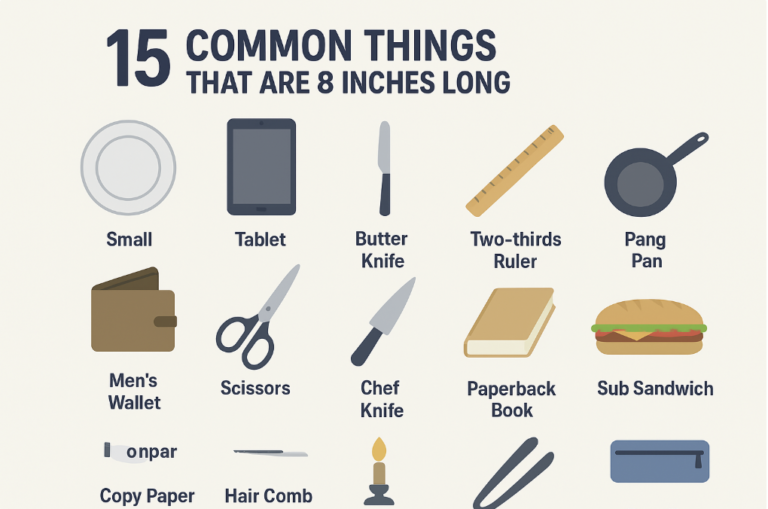Things That Are 20 Feet Big: 9 Common Things

Things that are 20 feet big include giraffes, shipping containers, school buses, elephants, ladders, shipping trucks, escalators, and basketball hoops.
Are you curious about the common things that are 20 feet big?
From the magnificent height of giraffes to the practical size of shipping containers, we’ll explore these intriguing objects.
Picture the immense presence of an elephant or the overwhelming length of a school bus.
Within this height range, you’ll also find towering ladders, spacious shipping trucks, and even basketball hoops.
Let’s not forget the impressively tall giant sunflowers that can reach up to 20 feet or the continuous motion of escalators that transport us conveniently.
Join us as we delve into the world of these nine common things that tower above us on a grand scale.
How Long Are 20 Feet? – A Guide to Measuring 20 Feet
Understanding lengths and measurements is a fundamental aspect of our daily lives.
Here, we will explore the question, “How long are 20 feet?” and provide insights into how to measure this length accurately.
20 feet is a unit of length, and it is equal to 240 inches, 6.096 meters, or 20 yards.
Things That Are 20 Feet Big
The equivalent length of 20 feet in various units of measurement:
| Unit of Measurement | Equivalent Length of 20 Feet |
|---|---|
| Meters | 6.096 meters |
| Centimeters | 609.6 centimeters |
| Millimeters | 6,096 millimeters |
| Kilometers | 0.006096 kilometers |
| Yards | 20.00 yards |
| Inches | 240.00 inches |
| Miles | 0.00378894 miles |
| Nautical Miles | 0.00328821 nautical miles |
| Chains (Surveyor’s) | 1.00 chains (surveyor’s) |
| Fathoms | 3.33 fathoms |
| Rods (Poles or Perches) | 5.00 rods (poles or perches) |
| Hands (Horses) | 60.00 hands (horses) |
| Cubits | 10.00 cubits |
These conversions are approximate and provide a convenient reference for understanding the length of 20 feet in various units of measurement commonly used in different contexts.
20 feet is a unit of length commonly used in the United States and some other countries. To be precise, 20 feet is equivalent to approximately 6.096 meters.
To put this into perspective, here are a few comparisons to help you visualize the length of 20 feet:
Two Small Cars: The average length of a compact car is roughly 10 feet. Therefore, 20 feet would be equivalent to the length of two such cars parked bumper to bumper.
The Height of Two Giraffes: The height of an adult giraffe typically ranges from 14 to 18 feet. So, 20 feet would be slightly taller than two giraffes stacked on top of each other.
Half the Length of a Standard Shipping Container: Standard shipping containers come in two sizes, with the smaller one being 20 feet in length. These containers are commonly used for transporting goods worldwide.
Measuring 20 Feet Accurately
Measuring a length of 20 feet accurately is essential in various contexts, from construction to event planning.
Here are some common methods and tools you can use to measure 20 feet:
1. Tape Measure:
A tape measure is one of the most accessible tools for measuring lengths, including 20 feet.
Most tape measures used in the United States have both metric and imperial units, making it easy to measure in feet.
Simply extend the tape measure to the desired length, and you can read off the measurement in feet and inches.
2. Measuring Wheel:
A measuring wheel, also known as a surveyor’s wheel, is a specialized tool designed for measuring longer distances accurately.
It consists of a wheel that rolls along the ground, and the number of wheel revolutions is used to calculate the distance.
Measuring wheels are particularly useful for measuring distances in a straight line.
3. Surveyor’s Equipment:
For highly precise measurements, professional surveying equipment such as a total station or a laser distance meter can be used.
These instruments are often employed in construction, land surveying, and engineering projects where accuracy is paramount.
4. Step Count:
In informal situations, you can estimate a distance of 20 feet by counting your steps.
An average adult’s walking stride is about 2.5 feet, so taking approximately eight steps will get you close to 20 feet.
This method is handy for quick, rough measurements when you don’t have access to measuring tools.
5. Marking the Ground:
In certain scenarios, like event planning or sports field marking, you can mark the ground at specific intervals to create a 20-foot reference.
This can be done using chalk, paint, or other suitable marking materials, ensuring that the measured area remains consistent.
Things That Are 20 Feet Big: 9 Common Things
Size matters, and sometimes, bigger is better.
In our daily lives, we encounter objects of various sizes, from the minuscule to the massive.
Something is fascinating about objects that are around 20 feet in size — they’re large enough to command attention but not so colossal that they become overwhelming.
Common things that are typically around 20 feet in size:
| Common Things | Approximate Size | Description |
|---|---|---|
| School Bus | About 20-40 feet in length | A large vehicle used for transporting students to school |
| Shipping Container | 20 feet in length | The tallest terrestrial animal with a long neck |
| Giraffe | Around 18-20 feet tall | Tallest terrestrial animal with a long neck |
| Basketball Court | 94 feet in length | Standard size for a basketball playing surface |
| Moving Truck | 20-26 feet in length | Used for transporting household goods during moves |
| Travel Trailer | About 20 feet in length | A towable recreational vehicle for camping |
| Semi-Truck Trailer | About 53 feet in length | Used for long-haul transportation of goods |
| Fire Truck | Typically around 20 feet | Emergency vehicle equipped with firefighting equipment |
| Humpback Whale | Around 40-50 feet in length | A large marine mammal known for its distinctive hump |
These are approximate sizes for these common things, as the actual dimensions can vary slightly depending on the specific model or species.
Here, we’ll explore nine common things that typically come in at around 20 feet, providing an interesting perspective on the world around us.
1. Shipping Container (20 Feet):
The humble shipping container might not be glamorous, but it plays a pivotal role in the global economy.
Measuring precisely 20 feet in length, the standard shipping container is a universal unit for transporting goods across the seas and continents.
These steel giants can hold an impressive amount of cargo and are the unsung heroes of international trade, ensuring that everything from electronics to clothing reaches its destination safely.
2. Moving Truck (Approximately 20 Feet):
When it’s time to move your household belongings from one place to another, a trusty moving truck often comes to the rescue.
Many rental moving trucks are approximately 20 feet in length.
They offer ample space to pack up your life and relocate it to a new home.
The familiar sight of these trucks on moving day symbolizes a fresh start and new beginnings.
3. Travel Trailer (About 20 Feet):
For those seeking adventure on the open road, a 20-foot travel trailer can be the perfect companion.
These compact RVs provide comfortable accommodations for travelers and campers.
With amenities such as sleeping quarters, a kitchenette, and a bathroom, they offer a home away from home.
Whether you’re exploring national parks or taking a cross-country road trip, a 20-foot travel trailer can be your ticket to adventure.
4. School Bus (Around 20-40 Feet):
Every weekday morning, children across the world board these iconic yellow vehicles for an education journey.
School buses vary in size, with the classic yellow bus typically being around 20 feet in length.
However, larger buses can stretch up to 40 feet. These vehicles are a symbol of the pursuit of knowledge and the promise of a brighter future.
5. Fire Truck (Typically around 20 Feet):
When disaster strikes, firefighters rush to the scene in their formidable fire trucks.
While fire trucks come in various sizes, some of the smaller engines used for urban firefighting operations are typically around 20 feet long.
These vehicles are equipped with essential firefighting equipment, including hoses, ladders, and water tanks, ready to battle blazes and save lives.
6. Motorboat (Approximately 20 Feet):
For those who love the water, a 20-foot motorboat can be a source of endless enjoyment.
These boats are perfect for day trips on the lake, fishing excursions, or even watersports.
With enough space to accommodate a small group of friends or family, these motorboats offer a gateway to aquatic adventures.
7. Giraffe (Around 18-20 Feet Tall):
Nature’s giants, giraffes, are the tallest terrestrial animals on Earth. On average, these magnificent creatures stand around 18 to 20 feet tall.
Their long necks and distinctive spotted patterns make them easily recognizable and a favorite at zoos and wildlife reserves.
Giraffes exemplify the awe-inspiring diversity of life on our planet.
8. Tractor Trailer (Semi-Truck):
The backbone of the transportation industry, semi-trucks, commonly referred to as tractor-trailers, are the workhorses of the road.
While the trailer portion of a semi-truck can be much longer, the tractor (or cab) is typically around 20 feet in length.
These trucks crisscross the country, hauling goods that keep our economy moving.
9. Basketball Court (94 Feet in Length):
While not entirely 20 feet big, a standard basketball court is worth mentioning.
It measures approximately 94 feet in length.
However, the playing area itself, marked by the court’s boundaries, is often around 20 feet wide and 47 feet long.
Basketball courts are where athletes showcase their skills, teamwork, and determination, making it a place of both competition and camaraderie.
These common things that hover around the 20-foot mark are a testament to human ingenuity, the wonders of the natural world, and our desire to explore and connect.
From the vastness of the open road in a travel trailer to the precision of international trade with shipping containers, these objects remind us of the diverse facets of our modern lives.
Massive Ships
Massive ships, such as aircraft carriers, cruise ships, and cargo ships, are truly awe-inspiring.
These colossal structures measure up to 20 feet and capture our imagination with their sheer size and capacity.
When you see an aircraft carrier, you can’t help but feel a sense of wonder at the engineering marvel that is capable of launching and recovering fighter jets.
Cruise ships, on the other hand, offer luxurious experiences for thousands of guests, with numerous decks and facilities.
Cargo ships, with their massive storage capacity, transport goods across the seas, ensuring the global economy keeps running smoothly. These 20-foot giants are a testament to human ingenuity and serve an important role in our modern world.
Whether used for defense, leisure, or commerce, massive ships are truly a sight to behold.
FAQ’s
How long is 20 feet in meters?
20 feet is approximately equal to 6.096 meters.
What are some common objects that are around 20 feet in size?
Common objects that are typically around 20 feet in size include shipping containers, moving trucks, travel trailers, school buses, fire trucks, motorboats, some semi-truck trailers, basketball courts, and even giraffes.
Why are shipping containers 20 feet long?
The standard shipping container size of 20 feet was established for practical reasons. It strikes a balance between being large enough to hold a substantial amount of cargo and being small enough to easily handle and transport.
How can I accurately measure 20 feet?
You can accurately measure 20 feet using tools such as a tape measure, measuring wheel, or surveyor’s equipment, or by counting your steps if you’re estimating roughly. Each method has its advantages depending on the context.
Are all school buses exactly 20 feet long?
No, not all school buses are exactly 20 feet long. School buses can vary in length, with the classic yellow school bus typically being around 20 feet, but larger buses can extend up to 40 feet.
What are some uses for a 20-foot travel trailer?
A 20-foot travel trailer is a popular choice for camping and road trips. It provides comfortable accommodations with sleeping quarters, a kitchenette, and a bathroom. It’s versatile and suitable for exploring national parks, campgrounds, and various outdoor destinations.
Why is it important to know the size of objects that are 20 feet big?
Knowing the size of objects that are around 20 feet big can be crucial for various purposes, including transportation, construction, event planning, and safety considerations. It helps ensure that objects fit within specific spaces and meet certain requirements.
How tall is a giraffe, which is around 20 feet big?
Giraffes are known for their long necks, and on average, they stand around 18 to 20 feet tall. They are the tallest terrestrial animals and are a fascinating part of the animal kingdom.
What’s the significance of 20 feet in shipping and logistics?
A 20-foot shipping container is one of the standard sizes used in shipping and logistics worldwide. It plays a critical role in international trade by providing a consistent and efficient way to transport goods by sea, land, and rail.
Is 20 feet the standard size for all basketball courts?
No, 20 feet is not the standard size for all basketball courts. A standard basketball court typically measures 94 feet in length. However, the playing area itself is often around 20 feet wide and 47 feet long, with variations depending on the level of play and regional standards.
Conclusion
To wrap up, it’s fascinating to highlight the multitude of things that exist measuring 20 feet.
From towering giants like giraffes and palm trees to more commonplace structures such as shipping containers and buses, these 20-foot-sized objects are remarkable in their own right.
They not only serve practical purposes, like offering shade or transporting people, but they also capture our imagination and leave a lasting impact.
Whether it’s witnessing the majesty of a basketball hoop or the artistry of a graffiti mural, these 20-foot big things remind us of the vast array of wonders that exist in our world.
So next time you encounter one of these colossal structures, take a moment to appreciate the beauty and significance they possess.
And remember, size isn’t everything, as even the smallest things can leave the biggest impression.






